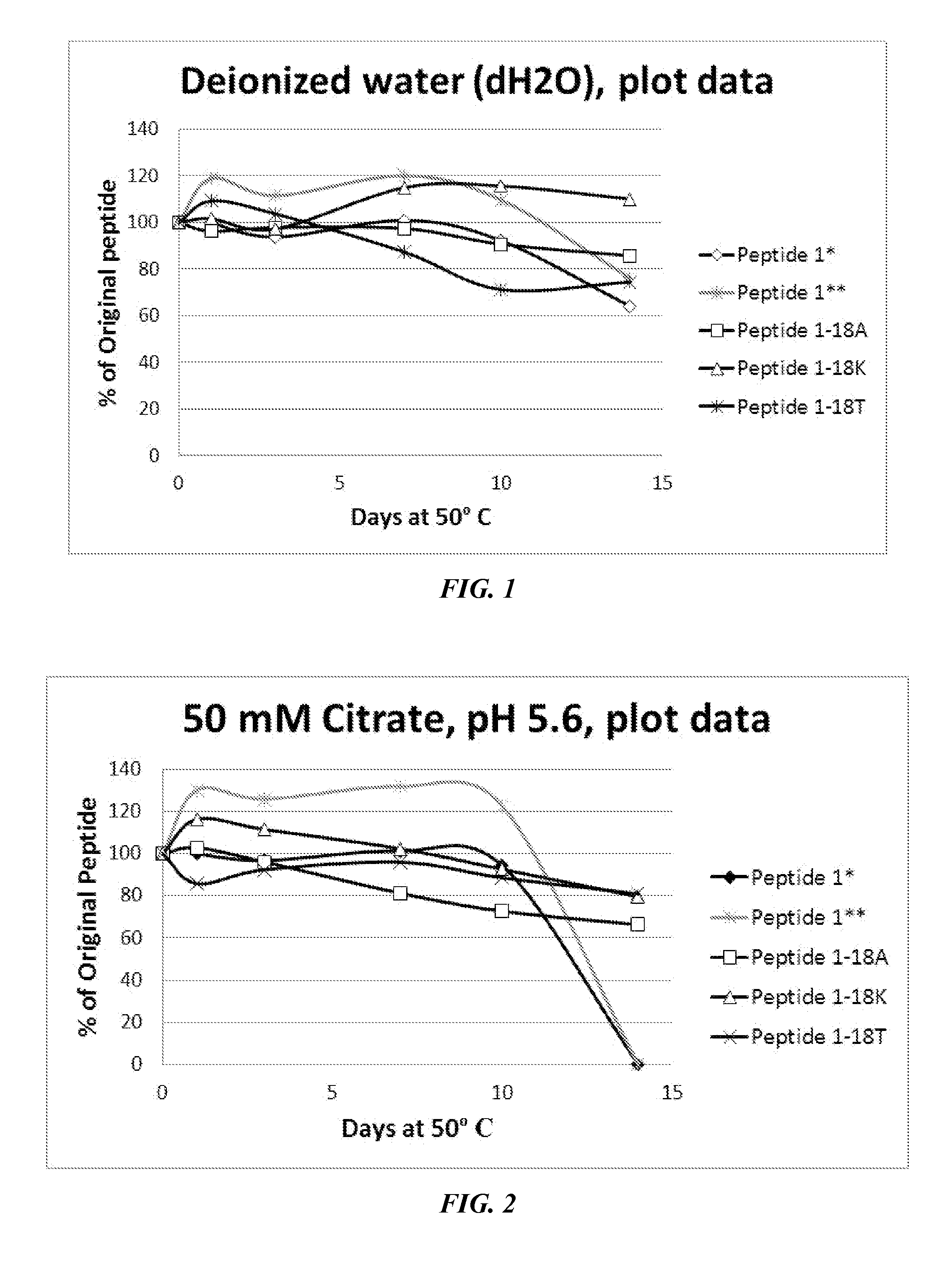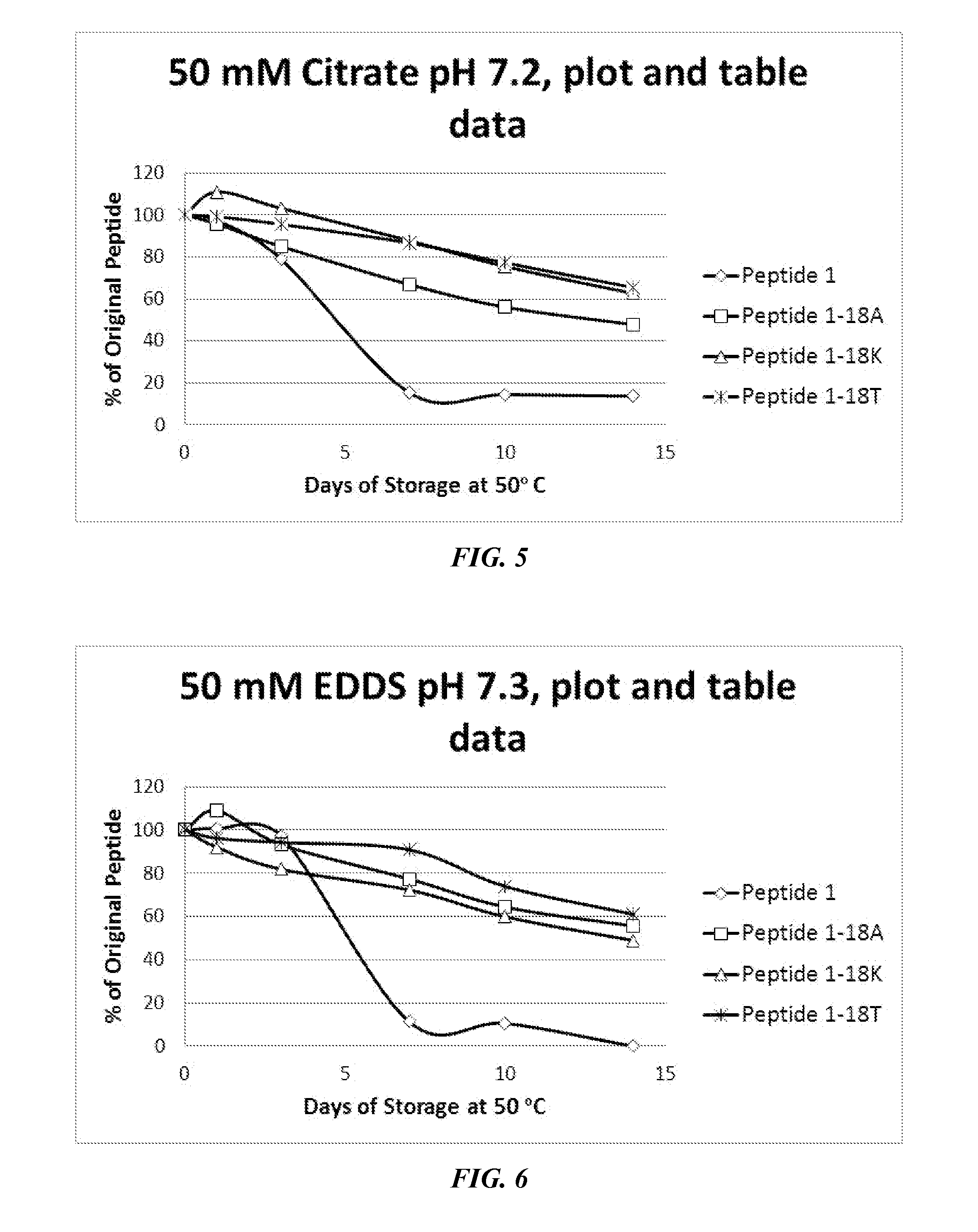Hypersensitive response elicitor peptides and use thereof
a technology of hypersensitive response and elicitor peptide, which is applied in the field of new products, can solve the problems of limit the use and versatility of harpin proteins, protein solubility and stability, etc., and achieve the effects of enhancing the longevity of fruit, enhancing the longevity of ripeness, and improving solubility and stability
- Summary
- Abstract
- Description
- Claims
- Application Information
AI Technical Summary
Benefits of technology
Problems solved by technology
Method used
Image
Examples
example 1
Development of “HR Box” Peptides of SEQ ID NO: 93
[0525]The HR box was originally developed based on examination of a number of Hypersensitive Response-Inducing sequences (P1, SEQ ID NO: 4; P4, SEQ ID NO: 5; and P15, SEQ ID NO: 64, among others). A repeating sequence of leucine and isoleucine residues was identified. P4 was chosen as a representative sequence as the basis for mutational studies that would reveal the sequence determinants of HR elicitation. HR in tobacco was tested as described in Wei, Science 257:85-88 (1992), which is hereby incorporated by reference in its entirety. Briefly, peptides were dissolved at a concentration of 500 μg / ml in aqueous solution. Four serial dilutions were performed with an equal volume of water, yielding peptide samples at 500, 250, 125, 62.5, 31.25 μg / ml peptide solutions. Nicotiana tabacum cultivar xanthi plants were used at 5-7 weeks old (preflowering). Leaves were lightly punctured with a toothpick in a middle leaf panel. Peptide solutions...
example 2
Solubility and Stability of P1 and Mutant Peptides
[0537]As described above, P1 and P1-derived sequences mutated at position 18 (methionine replaced with alanine, threonine, or lysine) were assessed for solution stability and chemical compatibility for 14 days. Notably, P1 exhibited solubility problems at lower pH (in deionized water solution, in 50 mM citrate pH 5.6, and in 50 mM MES pH 6.0). In these cases, the peptide concentration increased after 24-hour incubation at 50° C. Notably, the mutant peptides generally did not exhibit this issue. As shown in FIGS. 1-3, data were normalized to 100% peptide at the day 1 time point (shown as peptide 1* in the legend and the original peptide 1 data is marked with a double asterisk **). In a stability test dissolved in water (FIG. 1), peptide 1 was modestly stable, but exhibited solubility issues. The 18K and 18A mutants exhibited slightly higher stability (10-25% after 14 days). Dissolved in a slightly acidic citrate buffer (FIG. 2), P1 ex...
example 3
Solubility and Stability of P4 and Mutant Peptides
[0539]As described above, P4 and P4-derived sequences mutated at position 14 (cysteine replaced with alanine / A, aspartic acid / D, lysine / K, glutamine / Q, and serine / S) were assessed for solution stability and chemical compatibility for 14 days. In general, peptide 4 exhibited very poor stability due to the presence of cysteine (FIGS. 12-21). After less than 1 day, the original P4 HPLC peak was not detected in the samples. By comparison, all mutants exhibited better stability. Most of these retained at least 50% of the original material for 14 days at 50° C. In general, peptide 4 mutants exhibit better stability at higher pH values (>7.0). Notably, p4-14s can regularly exhibit stability of 90% after 14 days, depending on conditions. All of the mutant peptides exhibited the hypersensitive response when infiltrated into tobacco leaves (as in example 1).
PUM
| Property | Measurement | Unit |
|---|---|---|
| Fraction | aaaaa | aaaaa |
| Fraction | aaaaa | aaaaa |
| Solubility (ppm) | aaaaa | aaaaa |
Abstract
Description
Claims
Application Information
 Login to View More
Login to View More - R&D
- Intellectual Property
- Life Sciences
- Materials
- Tech Scout
- Unparalleled Data Quality
- Higher Quality Content
- 60% Fewer Hallucinations
Browse by: Latest US Patents, China's latest patents, Technical Efficacy Thesaurus, Application Domain, Technology Topic, Popular Technical Reports.
© 2025 PatSnap. All rights reserved.Legal|Privacy policy|Modern Slavery Act Transparency Statement|Sitemap|About US| Contact US: help@patsnap.com



